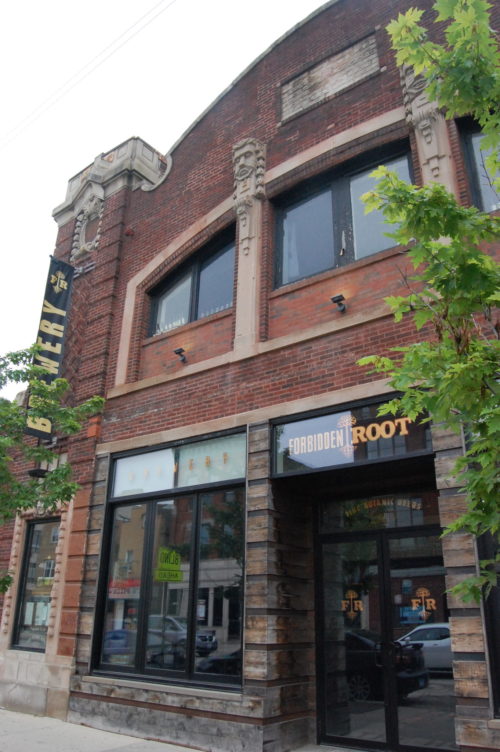(This article originally appeared in the August 2018 edition of LI’s print newsletter, The Arch.)
When Forbidden Root, a brewery in Chicago’s West Town, was planning to open its restaurant and brewery, it was looking for a space that fit the company’s culture of being “open, interesting, welcoming and unique,” according to Founder and Rootmaster Robert Finkel.
“For us, letting the building help tell our story was critical,” he said.
Since craft breweries are increasingly common, not just in Chicago but throughout the nation, Forbidden Root needed a space as distinct as its botanic beers.
“In a world where the consumer has a choice of thousands of craft beers, a visual context that speaks to our individuality was very important,” Finkel said.
The brewery found its home in a more than 100-year-old historic building that once housed The Hub Theater and was designed in the neoclassical style by David Saul Klafter. The moment Finkel walked into the building, he saw the potential.
“The opportunity to preserve and build on the past is a form of respect to move forward by looking back,” said Finkel. “It was a beautiful stick waiting to be whittled into something new.”
Forbidden Root is among a growing number of breweries in Chicago and Illinois reusing historic spaces. These breweries are also often connecting the characteristics of their beer, brewing methods and culture to the space where they are serving it. There are more than 200 breweries in Chicago and its suburbs alone, a growing number of which are housed in historic buildings. Plenty more exist throughout the state, too, and we plan on visiting them soon and sharing their stories. For this edition, we focus solely on Chicago.
Ellen Stoner is a Principal at Chicago architecture firm AltusWorks, which has worked with breweries to reuse historic buildings. She said a major attraction for breweries that reuse industrial buildings are their interesting, original features.
“No two are alike,” Stoner said. “And they are cost effective and flexible to convert.”
One of AltusWorks’ recent projects was Metropolitan Brewing’s Rockwell Taproom, which opened in 2017 in Chicago’s Avondale neighborhood along the Chicago River. The taproom is located in part of the former 1921 JM & V Weil Tannery, and recently won an award from the Friends of the Chicago River for its river-sensitive design. Metropolitan also highlighted the building’s historic details in its reuse of the space, like heavy steel columns and beams and load-bearing masonry walls, said Stoner.
The exposed masonry inside Motor Row Brewery, on South Michigan Avenue, is another example of an original feature that helps share the story of the historic space. The brewery is located in Chicago’s historic Motor Row District – considered to be the largest intact early “motor colony” in the U.S. According to Ali Noe, Motor Row Brewery’s Brand, Media and Marketing Manager, the wood slats in the Chicago-style brick walls of the brewery often catch the attention of customers and lead them to ask about the history of the building.
“People love stories,” said Noe. “It’s a good conversation piece.”
Maintaining the historic integrity of the Chicago Landmark that now houses Motor Row Brewing was challenging, especially when it came to restoring the façade, said Bob Lassandrello, the father of the father-son ownership team behind the brewery. It was, however, rewarding. The rehabilitation project won a 2015 “Chicago Landmark Preservation Award” from the City of Chicago.
“I love this space and the history it holds for its depth, heart and soul,” said Lassandrello. “It doesn’t feel like a blank slate, the space feels lived in and comfortable.”
By opening in historic buildings, these breweries are not only sharing their beers with thirsty customers, they are preserving a piece of the past and keeping our local history alive.
Eris Brewery and Cider House, on Irving Park Road on the city’s Northwest Side, is housed in a 107-year old, former Masonic Temple. It was the building’s rich history of serving as a community gathering space that attracted Eris co-founder Michelle Foik. Thanks to Eris’ rehabilitation of the building, community members once more can gather inside – this time over a pint.
“I can literally watch the mouths of the guest(s) drop open when they come in and look at the place,” said Foik. “They are all interested in the space, and love the look and how we repurposed many elements of the building.”
Know of a brewery located in a historic building? Email Kaitlyn McAvoy at kmcavoy@landmarks.org. Stay tuned for more stories of breweries in historic spaces. Next, we will head to the suburbs and elsewhere throughout the state!
Read the full August 2018 edition of The Arch newsletter:

